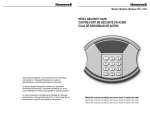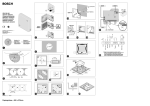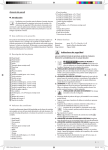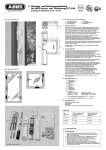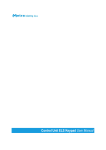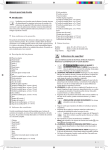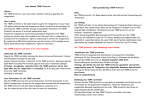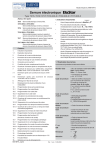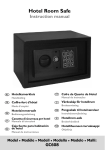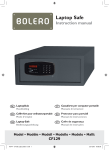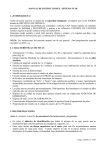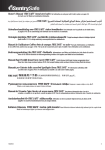Download trend manual 2005
Transcript
English English TREND I & II Dear Customer, Congratulations on the purchase of your SecureLine security product. We would like to thank you for expressing your confidence in our product through your choice. TI/II - 18K TI/II - 27K - English TI/II - 27E TI/II - 32K TI/II - 32E TI/II - 44K TI/II - 44E TI/II - 41K TI/II - 41E TI/II - 61K Your SecureLine safe will help protect your valuables against the rising tide of crime and help prevent the loss of possessions with a high sentimental value. This manual contains the information required to achieve maximum benefit from your safe. We recommend that you read the entire manual carefully. After all, you cannot be too careful when it comes to protecting your property. TI/II - 61E page 03 • We wish you many years of security! • Note: Keep this document in a secure place away from the safe. Deutsch What have you received? Nähe des Tresors. page 15 • • Note: Conservez ce document en lieu sûr, à distance du coffre-fort. Español página 21 • • Nota: Guardar este documento en lugar seguro fuera de la caja fuerte. Italiano pagina 27 • Please check carefully that you have received the following items. If not, please contact your supplier. • 2 keys, only if your safe is equipped with a key lock. • 4 batteries, 1 battery holder and 2 override keys, only if your safe is equipped with an electronic lock. • User manual. • Fixing set consisting of: screws, plugs and washers, plastic covers / caps. • A shelf and shelf supports, if your safe is equipped with a removable shelf. • Nota: Conservare questo documento in un luogo sicuro lontano dalla cassaforte. Nederlands What can you store in this safe? • sida 39 • • Notera: Förvara detta dokument på ett säkert ställe långt från skåpet. Suomeksi • sivu 45 • Huomautus: Pidä tämä käyttöopas turvallisessa paikassa kassakaapin ulkopuolella. • • 02 Opening and closing the safe. Please check that the safe works correctly before installing it or securing items inside. Opening the safe 1. Insert one of the keys supplied in the keyhole. Note: the key only fits the keyhole in one position: do not force it! 2. Turn the key clockwise until it stops. Do this gently. The door can now be opened by pulling the key towards you. Closing the safe 1. Insert one of the keys supplied in the keyhole. Note: the key only fits the keyhole in one position: do not force it! 2. Ensure that the bolts are not protruding (the bolts are the metal pins which protrude from the side of the door and thus secure the safe). If necessary, turn the key clockwise turn to retract the bolts. 3. Gently push the door shut. Now turn the key anti-clockwise until it stops. 4. Now remove the key from the keyhole and store it safely away from the safe. pagina 33 • Noot: Houdt dit document op een veilige plaats buiten de kluis. Svenska For safes equipped with a key lock: Seite 09 • • Hinweis: Bewahren Sie diese Anleitung an einem sicheren Ort und nicht in direkter Français * A Tip: Some insurers appreciate it if you store your valuable property in a good safe. Therefore ask your insurance company what effect this will have on your premium. The high quality security offered by your safe can make a significant difference. 51 A • • • • • • • few suggestions: Jewellery Heirlooms Cash Credit cards, cheques Photographic and video equipment Passport, driving licence, birth certificates Insurance documents Note: We recommend that the spare key is not kept in the safe. * Please note that this product is not designed to protect computer or Hi-Fi media. Depending on where you locate your safe, it may be subject to humidity. Stamps and other delicate items should therefore be stored in an airtight container before being put in the safe. 03 English English For safes equipped with an electronic lock: What should you do before using the safe for the first time? Please check that the safe works correctly before installing it or securing items inside. Access codes The electronic lock has two access codes and are programmed independently from each other. Default both access codes are active and must be changed before you use the safe. LCD display emergency key hole pull knob battery socket battery holder 1. Install the 4 batteries in the battery holder. 2. Plug the battery holder into socket of keypad (located at the bottom of the keypad); the LCD display will show “ -SL- “. 3. Enter the default factory code: 1 2 3 4 5 6 or 8 8 8 8 8 8. The door will unlock and the LCD display will show “OPENED”. 4. Remove the battery holder and remove the batteries from the battery holder. Store the battery holder safely away from the safe. 5. Open the door. 6. Open the lid of the battery compartment at the back of the door. 7. Fit the batteries, ensuring that the positive and negative terminals are aligned correctly; the LCD display will show “ -SL- “. 8. Now change the 1st and 2nd access code; this is done as follows: Changing the 1st access code Note: this can only been done when the safe is unlocked and the door is open. 1. Press button: * * 1. The LCD display will show “-PROG-” and “-CODE-”. 2. Enter now your personal 6-digit code. The LCD display will show “-GOOD-”, when the new code is stored correctly. 3. DO NOT CLOSE THE DOOR YET!; test the new code before closing the safe. Go to “Testing the electronic lock”. Changing the 2nd access code Note: this can only been done when the safe is unlocked and the door is open. 1. Press button: * * 2. The LCD display will show “-PROG-” and “-CODE-”. 2. Enter now your personal 6-digit code. The LCD display will show “-GOOD-”, when the new code is stored correctly. 3. DO NOT CLOSE THE DOOR YET!; test the new code before closing the safe. Go to “Testing the electronic lock”. battery compartment Default factory codes The electronic lock is supplied by the manufacturer with the standard access codes 1 2 3 4 5 6 (1st code) and 8 8 8 8 8 8 (2nd code). These codes must be changed before you use the safe. Now do the following: 04 Testing the electronic lock The lock should only be tested with the door open! 1. Press button: #. The LCD display will show “CLOSED” and the bolts will be pushed out. 2. Enter your personal code. The LCD display will show “OPENED” and the bolts will retract. 3. If steps 1 and 2 are carried out successfully, you can close the door and lock the safe. Closing the safe 1. Close the door and keep it gently pressed shut with one hand. 2. Now press button: #. The LCD display will show “CLOSED” and the lock mechanism will be activated and the bolts (these are the metal pins in the side of the door) will be pushed out. Opening the safe 1. Enter your personal code; If the code has been entered correctly the LCD display will show “OPENED” and the door will unlock. 2 The door can be opened further by pulling the black pin (left side in keypad) towards you. • If an incorrect access code has been entered, the LCD display will show “Error” or ”E-Code”. • If the safe is not closed within 10 sec. you will hear 2 short beeps as notification. • An incorrect input can be cancelled by pressing the * button. • If an incorrect access code has been entered three times, the lock will be blocked for 5 minutes and the LCD display will show “HOLD05”. Security feature If required the LCD input can be made unreadable while entering your code. This feature is also called “anti-spy” function and is enabled when pressing the * button before entering your personal access code. The LCD display shows “- - - - - -“ and not your code! Emergency opening 4. Turn the key clockwise turn until it stops. Do this gently. The door can now be opened by pulling the key towards you. 5. The batteries can be replaced and the door can be closed again. 6. Gently push the door shut. Now turn the key anti-clockwise until it stops. 7. Remove the override key and store if safely away from the safe. 8. Put back the plastic cover in the key hole. 9. You can again use your personal access code to open the safe. Replacing the battery When the safe is locked the battery power can be checked by pressing the # button. When the batteries have sufficient power, the display will show “HI-BAT”. If the display shows “LO-BAT” the batteries are weak and shall be replaced as soon as possible. We recommend that you use only alkaline model LR6-AM3-AA-1.5V batteries. To replace the batteries, follow these steps: 1. Open the door. 2. Open the lid of the battery compartment at the back of the door. 3. Replace the batteries; ensuring that the positive and negative terminals are aligned correctly; the LCD display will show “ -SL- “. 4. DO NOT CLOSE THE DOOR YET!; test the new code before closing the safe. For this, see the instructions on “Testing the electronic lock”. 5. If the lock works correctly, you can close the safe. Attention • Do not store your user manual and override keys in the safe, but safely away from the safe. Your safe is equipped with a mechanical override in case an emergency opening is necessary. • When the batteries are weak, the LCD display will show “LO-BAT”. The safe can be opened by plugging the battery holder (with new batteries!) into the socket of keypad - located at the bottom of the keypad. Follow the normal procedure. 1. If the safe can not be opened via the normal procedure you can open the safe with the emergency override key. 2. Remove the plastic cover located on the right side below the keypad. 3. Insert the override key. Note: the key only fits the key hole in one position: do not force it! 05 English English Positioning and fixing of the safe Securing instructions Where should I place my free-standing safe? Recommendation No safe is completely thief-proof. With time and the right tools any safe can be broken into, so it makes sense to observe the following: 1. It is important that the safe is as inconspicuous as possible. We recommend that you never place the safe anywhere where it is visible from outside. For example, place your safe in a cupboard or in the utility room. 2. If you have electronic security i.e. an alarm, the safe is best positioned within the protected room. 3. Place the safe with the hinge away from the wall as this makes it harder to try the door open on the lock side. 4. Position the safe as near to the floor as possible in case of outbreak of fire. 5. Keep keys and combination numbers hidden and away from the safe. We recommend that you secure your safe with the screws provided to both the floor and the wall. This offers the best protection against unauthorised removal of your safe. Your safe is equipped with four fixing holes for this purpose: two in the bottom and two in the back. The quality of the fixing is dependent on the quality and nature of the floor and wall into which the fixing screws are screwed. The best results will be achieved if you place the safe on a concrete or stone floor against a concrete or stone wall. If you wish to install it on a wooden floor it may be desirable to use different fixings to ensure optimum fixing strength. Various types of anchor bolts are available for use in wood which can give a better result that the screws supplied. The choice of fixings is largely determined by the thickness and type of wood on which the safe is placed. How and with what can I secure my free-standing safe? What do you need? Your safe is equipped with two holes in the bottom and two holes in the back. Using the supplied fixings, you can secure the safe to the floor and/or to the wall. For a detailed description of how to secure your safe, please see figure 1. This gives a step by step guide to securing the safe. To secure the safe you need fixings and tools. Before starting to secure the safe, check that you have the following items to hand: 1. The fixing set supplied. This set consists of: fixing screws, metal washers, plastic covers / caps. 2. An electric (hammer) drill. If the base material is concrete, you will need a hammer drill. 3. The fixing holes in the base material need to be drilled first. If the base material is concrete or stone, you will need a concrete drill bit. If the base material is wood, use wood drill bit. Note: you may therefore require both drill bits, for example if the floor is made of concrete and the wall is wood. 4. A socket wrench. 5. A vacuum cleaner to clear the drill holes. 6. Possibly a hammer. Installation instructions Maintenance 1. Place the safe in the position you have selected. Before marking or drilling any holes ensure that there are no pipes or cables present at the fixing points. If there is skirting board present at the desired fixing point, this should be removed to allow the safe to be fitted flush to the wall. 2. Open the safe and remove any shelves. 3. Using a pencil or a sharp object, mark out the four drill holes; two on the floor and two on the wall. (Always try to secure the safe with four screws). 4. Close the safe. 5. Now move the safe to give enough room to drill the fixing holes. 6. Drill holes: you will need the concrete drill bit for a concrete base material, and the wood drill bit for a wooden base material. 7. Clear the drill holes and remove any drilling debris using a vacuum cleaner. 8. If you have drilled holes in a concrete floor, insert the plastic plugs supplied in the holes. Ensure that the end of the plug is level with the edge of the drill hole. If necessary, use a hammer to insert the plug. The plugs are not used when securing the safe to wooden floor and/or wooden wall. 9. Now position the safe so that the fixing holes on safe match the drill holes in the floor and/or wall. 10.Secure the safe using the fixing screws supplied. Slide the washer over the fixing screw before screwing it into the drill hole. You will need a socket wrench to drive in the screw. 11.On a double-walled safe, you can cover the fixing holes with the plastic covers. This is not possible on a single-walled safe. The two plastic caps can be used to cover any unused fixing holes from the outside. • Never throw your keys. Distortion of the key can damage the lock. • When closing the door, there should never be anything between the door and the safe (e.g. a paper clip). The bolts must be fully retracted. • Do not fill the safe to such an extent that it is hard to close the door. The locking mechanism could then seize up as a result of pressure on the inner plate. • Ensure that the key in the door does not hit a wall when opening. This can cause the key to snap, and can damage the locking mechanism. • If you find that the lock becomes harder to open or stiffer, never use oil or graphite powder to 'lubricate' the lock. This can make the tumblers sticky, which could prevent the lock from opening at all. Your supplier can advise you on the correct cleaning product to use. • The outside of your safe can be cleaned with a slightly damp cloth. Never use chemical cleaning agents. However, we recommend that you do not use just two screws to secure your safe. First re-read the manual. If you cannot find a solution, contact your supplier. Troubleshooting Although your safe has been manufactured with the greatest care, a fault may nevertheless occur, such as: • The locking mechanism does not work. • You cannot open your safe. • Faulty lock. • You lose your key. The most important rule is not to try and force anything. The locking mechanism in particular is made of precision components which can be damaged. Figure 1 06 07 English 1. All claims under the warranty must be accompanied by proof of purchase. 2. Claims under the warranty must be made to the dealer from which the unit was purchased. 3. The warranty applies only to the initial purchaser and is not transferable. 4. The warranty does not apply in the event of damage or faults which are the result of: a) Accidents, misuse, wear and tear, neglect, wilful damage, fire and or malicious attack. b) Incorrect installation and/or use in a manner which conflicts with the relevant legal, technical and/or safety standards. c) An unauthorised modification. d) Repairs carried out by anyone other than an authorised dealer or the manufacturer. e) Negligent transportation without appropriate packaging or protection. f) The erroneous programming of numerical, combination and/or electronic locks. 5. No claim will be accepted under this warranty involving losses occurring in transit. 6. Batteries and faults caused by incorrect insertion or use of batteries with the wrong voltage are excluded from the warranty. 7. The warranty gives no right to reimbursement of any loss apart from the replacement or repair of the faulty parts. The manufacturer cannot be held liable for any consequential loss or any other consequences caused by or connected with the products supplied by it, including loss or damage to items stored in it by theft, fire, water ingress, condensation, chemical attack or other means. 8. The costs of shipping, packing and shipping insurance will always be borne by the customer. 9. Only the manufacturer may amend the conditions of this warranty. 10.Repairs or site visits that are not covered under this warranty will be chargeable. Please first clarify with your dealer whether your claim is covered by warranty. In the unlikely event of a fault developing, please contact your supplier. www.Secure-Line.net 08 Sehr geehrter Kunde / Sehr geehrte Kundin, herzlichen Glückwunsch zum Kauf Ihres SecureLine Tresors. Wir freuen uns, dass Sie sich für ein Produkt von SecureLine entschieden haben. Der SecureLine Tresor schützt Ihre Wertsachen, Dokumente und unersetzlichen Erinnerungsstücke gegen Diebstahl. Diese Anleitung enthält alles, was Sie wissen müssen, um Ihren SecureLine Tresor optimal zu nutzen. Bitte lesen Sie sie genau durch. Schließlich kann man nicht vorsichtig genug sein, wenn es darum geht, sein Eigentum zu schützen. Wir wünschen Ihnen viele Jahre Sicherheit! * Ein Tipp: Einige Versicherungsgesellschaften bieten günstigere Beiträge an, wenn Sie Ihre Wertsachen in einem guten Tresor aufbewahren. Die hohe Sicherheit, die ein SecureLine Tresor bietet, kann hier einen wesentlichen Unterschied machen. Fragen Sie auf jeden Fall bei Ihrem Versicherer nach. Deutsch Standard Warranty terms Tresore mit Schlüsselschloss: Öffnen und Verschließen des Tresors. Bitte kontrollieren Sie, dass der Tresor ordnungsgemäß funktioniert, bevor Sie ihn verankern oder etwas darin einschließen. Das sollten Sie erhalten haben Öffnen des Tresors Bitte kontrollieren Sie, ob Sie Folgendes haben. Wenn etwas fehlt, beanstanden Sie dies bitte sofort bei Ihrem Händler. • 2 Schlüssel - nur bei Tresoren mit Schlüsselschloss. • 4 Batterien, 1 Batteriehalterung und Notöffnungsschlüssels - nur bei Tresoren mit Elektronikschloss. • Bedienungsanleitung • Befestigungsmaterial: Verankerungsschrauben, Dübel, Unterlegscheiben, große Kunststoffabdeckungen und kleine Kunststoffkappen. • Ein Einlegeboden und Einlegebodenunterstützung - nur bei Tresoren vorgesehen mit Einlegeboden. Das können Sie in diesem Tresor aufbewahren Einige Beispiele: • Schmuck • Erbstücke • Bargeld • Kreditkarten, Schecks • Foto- und Videoausrüstung • Reisepass, Führerschein, Geburtsurkunden • Versicherungsunterlagen * Bitte beachten Sie, dass dieser Tresor nicht zur Aufbewahrung von Computer-Datenträgern oder Hifi-Medien geeignet ist. Je nach dem Aufstellungs-ort Ihres SecureLine Tresors, ist eventuell eine Schwitzwasserbildung möglich. Briefmarken und andere empfindliche Artikel sollten deshalb in einem luftdichten Behälter im Tresor aufbewahrt werden. 08 1. Stecken Sie einen der mitgelieferten Schlüssel in das Schüsselloch. Hinweis: Der Schlüssel passt nur in einer Stellung: Versuchen Sie nicht, ihn mit Gewalt einzustecken! 2. Drehen Sie den Schlüssel vorsichtig im Uhrzeigersinn, und zwar um eine Viertel Umdrehung bis zum Anschlag. Sie können die Tür nun öffnen, indem Sie den Schlüssel auf sich zu ziehen. Verschließen des Tresors 1. Stecken Sie einen der mitgelieferten Schlüssel in das Schlüsselloch. Hinweis: Der Schlüssel passt nur in einer Stellung: Versuchen Sie nicht, ihn mit Gewalt einzustecken! 2. Stellen Sie sicher, dass die Riegelbolzen nicht ausgefahren sind (die Riegelbolzen sind die Metallstifte seitlich an der Tür, mit denen der Tresor verriegelt wird). 3. Schließen Sie die Tür vorsichtig. Drehen Sie dann den Schlüssel entgegen dem Uhrzeigersinn, und zwar um eine Viertelumdrehung bis zum Anschlag. 4. Ziehen Sie den Schlüssel ab, und verwahren Sie ihn an einem sicheren Ort entfernt vom Tresor. Hinweis: Bewahren Sie den Ersatzschlüssel nicht im Tresor auf. 09





